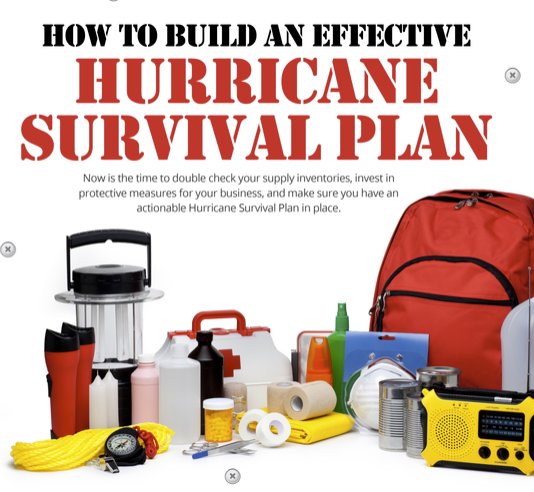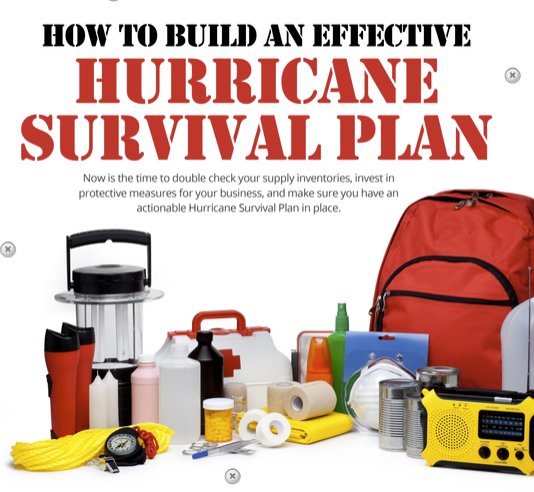
Hurricane Preparedness (Questions/Answers)
How to build an effective Hurricane Survival Plan
Now is the time to double check your supply inventories, invest in protective measures for your business, and make sure you have an actionable Hurricane Survival Plan in place.
The 2019 hurricane season is almost here – are you ready for it?
According to Moody’s Analytics, the 2018 hurricane season caused up to $50 billion in damages. Can you afford to be a part of however large that number becomes this year?
All of this is to say – we know when the hurricane season begins, and we can take steps to protect ourselves, our families, our homes and our businesses.
Without effective hurricane preparedness planning, your business can suffer devastating consequences during an emergency. Property damage and data loss can affect your resources, continuity and more, leading to loss of business, and lower return on investment in these resources.
What does effective planning for a hurricane really look like?
Key aspects of a Hurricane Survival Plan include:
Developing a Plan
As with most endeavors, the first step is to create a workable plan. Your business’ hurricane plan should be carefully constructed and written down for reference and review.
Remember, many companies are required to maintain an Emergency Action Plan by OSHA so this can be considered part of that process.
Your plan should put forth policies and procedures regarding employee safety, business continuity, and contingencies that can be activated if your business’ facilities are damaged.
There are three steps to an effective Hurricane Preparedness Plan:
Protect your property.
While so much of disaster recovery these days is focused on data continuity, it’s important to remember that your facilities are a resource as well, and they should be protected.
- Make sure your windows have proper shutters or are boarded up with plywood to keep them safe from airborne debris.
- Inspect your roof prior to each hurricane season to make sure it’s in good shape.
- Assess whether there are any aging branches or trees that could fall and cause damage during a storm. If you’re unsure, have an arborist check it out for you.
- Bring sandbags to areas that could be affected by flooding.
- Secure heavier objects, including bookcases, shelves, filing cabinets, computers, etc.
- Secure utilities, and raise them off the ground if necessary to avoid flood damage. Prior to the hurricane reaching your area, make sure they’re all turned off.
- Relocate any fragile or valuable items to less dangerous areas, if possible.
Protect your documents.
Once all your physical assets are taken care of, don’t forget about your business documentation.
- Make sure you have a backup of info on important business contacts.
- Backup documents that are not easy to reproduce or acquire in the event of water damage – insurance and legal contracts, tax files, etc.
- Keep as much of your documentation as possible in waterproof containers.
Maintain a checklist of survival resources.
Lastly, you’ll want to make sure you have an inventory of all the hurricane-specific resources you’ll need.
These are the types of items you won’t be using otherwise year-round, and so, when you do require them, you don’t want to realize you’ve forgotten something.
-
- Independently powered radio/TV
- Three-day supply of non-perishable food for as many employees as you have onsite (including 1 gallon of water per person per day)
- Blankets, pillows, cots, and chairs
- First Aid supplies
- Flashlights (and additional batteries)
- Toolkit
- Whistles and/or signal flares
- Tarps, plastic bags, and duct tape
- Cleaning supplies
- Smoke alarms and fire extinguishers
- Electric generator
- A backup supply of gas and additional jerry cans
- Cash, credit cards and ID
- Emergency contact info
Defining Procedures and Assigning Roles
Determine the critical staff that will need to be on-site or on-call during an emergency. It’s important to define who will be needed to keep your business running, and who should be responsible for any emergency response tasks. Remember that safety comes first and that your plan must focus on keeping your employees out of danger.
Coordination
A comprehensive plan should prepare your business to coordinate with others during an emergency. How are nearby businesses going to operate during a hurricane? How will police, fire, and medical response be affected? These questions are best answered before the storm hits.
Briefing Your Employees
Your hurricane plan should not be written and then left on a shelf. Every employee should be familiar with your procedures and plans to handle any future emergencies. Hold a meeting where your plan is reviewed, roles are assigned, and your staff can ask questions.
Reviewing and Updating Your Plans Annually
Changes in your business or the community in which you operate can have a major effect on your disaster plan. Be sure to review your plan at least once a year and make any necessary revisions to keep it current and effective.
What’s the bottom line of Hurricane Preparedness?
Effective hurricane preparedness keeps you safe and protects your assets, simple as that.
In addition to protecting yourself and your employees, proper business continuity planning should assess your individual requirements by estimating your current data retention needs and expected growth. You can then determine what systems are critical to your business and assess what recovery mechanisms are currently in place.
Based on this comprehensive analysis, you’re then able to build a hurricane preparedness plan that works best for your organization.
Remember – without comprehensive disaster recovery planning, you’re left vulnerable to any and all emergency situations, whether it’s a major meteorological event like a hurricane, or common — and still unpredictable — power outages. Consequences include:
- Permanent data loss as onsite copies of your data are destroyed
- Severe downtime as your business scrambles to replace hardware and get up and running again
- Major financial damages, from the cost of lost business to the cost of replacement hardware and more.
So, the question is: will you wait until after you get hit with a hurricane to start thinking about how you’ll recover?
Or will you do what’s right for your business, and start planning for the worst-case scenario today?






